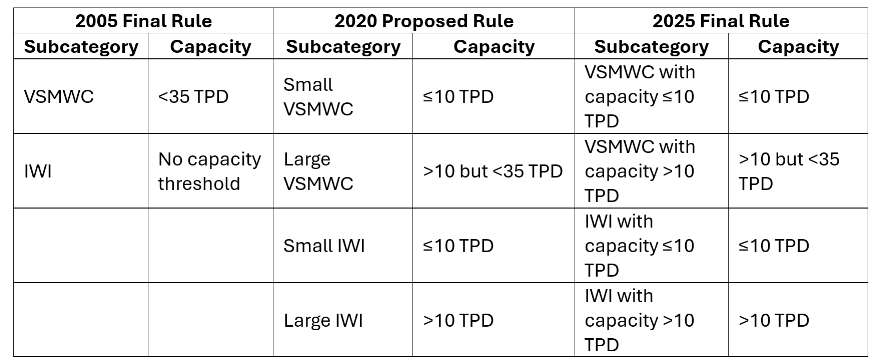EPA Updates Clean Air Act Standards Applicable to Small Waste Incinerators
On June 30, 2025, the U.S. Environmental Protection Agency (EPA) finalized updates to its New Source Performance Standards (NSPS) and Emission Guidelines for Other Solid Waste Incineration (OSWI) units under the Clean Air Act (CAA). These units — combustion systems that incinerate solid waste from commercial or institutional sources not otherwise regulated under specific incinerator categories — include very small municipal waste combustors and institutional incinerators. The final rule includes applicability-related and definitional changes expanding the class of incinerators subject to NSPS, revises the OSWI subcategories and tightens emission limits for key pollutants. It also adopts changes to startup, shutdown, and malfunction (SSM), and expands testing, monitoring, reporting, and recordkeeping requirements that will affect both existing and new OSWI units.
Applicability. OSWI categories subject to the Final Rule include very small municipal waste combustion (VSMWCs) and institutional waste incinerators (IWIs), based on a tons per day (TPD) capacity. Importantly, the Final Rule also broadens the scope of VSMWCs that would be subject to the rule by deemphasizing the source of certain waste streams as a basis for bringing a unit within the rule. According to the EPA, this will ensure small incinerators that burn more than 30% municipal solid waste (MSW) located on commercial or industrial sites — particularly incinerators owned by oil and gas companies that burn municipal-type solid waste generated by employees as opposed to oil and gas operations — would qualify as VSMWC. As such, these units are no longer subject to the Commercial and Industrial Solid Waste Incineration Units (CISWI) rule.

Regulatory Standards. For units that burn 10 or fewer tons of solid waste per day, the Rule introduces stricter controls on fine particulate matter (PM), as well as revised standards for pollutants attributed to the expected waste streams of chlorinated plastics, paper waste, PVC plastics, electronics, and organic waste: carbon monoxide (CO), dioxins/furans, hydrogen chloride, sulfur dioxide, nitrogen oxides, and metals including lead, mercury, and cadmium. These NSPS become effective on December 29, 2025. The EPA did not revise emissions limitations for units with a capacity of more than 10 tons of solid waste per day.
Other regulatory requirements include opacity limits, performance testing, continuous emissions monitoring system requirements for CO emissions, and extensive recordkeeping requirements. The Final Rule further requires continuous compliance with emission limits, including during SSM, and regulated units must establish SSM plans and operating parameters to minimize emissions during these transitional phases. Ultimately, the EPA anticipates that additional controls, such as a scrubber or baghouse, may be required to meet the new regulatory standards.
Compliance Deadlines. Compliance deadlines depend on the OSWI’s capacity and whether the OSWI is considered a new or existing unit. Under the Final Rule, new units are those which commenced construction after August 31, 2020, or commenced modification or reconstruction on or after December 29, 2025. Existing units, in contrast, may follow the state compliance timeline for any updated emission guidelines, and will have some flexibility as their compliance deadlines will depend on the EPA’s approvals of individual state compliance plans. State agencies must submit plans within one year; and existing units must come into compliance with the Final Rule as reflected in the state plan within three years of the EPA’s approval of the plan or by July 1, 2030 — whichever comes first. Other compliance deadlines, such as initial testing, are subject to requirements detailed in the regulatory tables found at 40 C.F.R. part 60, subpart EEEE.
The EPA’s overall approach. By moving ahead to finalize a Biden-era proposal, the Final Rule appears to mark a divergence from the Administration’s otherwise deregulatory agenda, although it is consistent with the EPA Administrator’s pillar that focuses on traditional clean air regulatory requirements. It may also reflect a concern at the EPA related to microplastics, particularly those emitted during the combustion of plastic-containing waste streams. Although the final OSWI rule does not explicitly address microplastic emissions, the EPA chose to retain pyrolysis/combustion units in the definition of municipal waste combustion unit, despite originally proposing to remove the reference in its 2020 Proposed Rule. It also further restricts PM emissions — a pollutant that the EPA has said can serve as a vector for airborne microplastic dispersal. The EPA has claimed the combustion of synthetic materials is a potential source of microplastic pollution in both air and ash residues. As such, the revised standards may represent an incremental shift in how the EPA plans to manage these emerging contaminants and evidences of potential scrutiny by the EPA in future actions concerning similar waste or emissions streams.
This post is as of the posting date stated above. Sidley Austin LLP assumes no duty to update this post or post about any subsequent developments having a bearing on this post.


